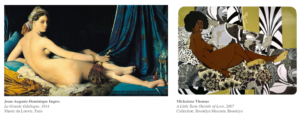The play deals with a variety of adult topics such as abortion and rape that would make it difficult to teach in its entirety in a high school. The language is also quite graphic in places. Yet, it’s so real, raw and emotional that I just want to share it with my students at the same time. For example, there’s a scene, told by three of the women at once, discussing date rape, that starts, “a friend is hard to press charges against/if you know him/you must have wanted it.” It continues, “ticket stubs from porno flicks in his pocket/a lil dick/or a strong mother/or just a brutal virgin…lock the door behind you/wit fist in face/to fuck…who make elaborate mediterranean dinners/& let the art ensemble carry all ethical burdens/while they invite a coupla friends over to have you/are sufferin from latent rapist bravado/& we are left wit the scars.” The intensity of Shange’s words, language and diction makes the experience of reading an personal and intimate violation like abortion and rape harsher. Through her words I feel like I am the protagonist, as I feel all the emotions and tensions that exists throughout each poem. I started writing a journal recently and thanks to Shange, I have started to explore my own truth in the ways that I confide in myself though writing. For so long my personal diaries and journals were polished and felt like I couldn’t be honest with myself. In For Colored Girls… I started to appreciate the value of healing through honesty of emotion and sincerity with myself first. I am interested in how Shange shifted the “explicitness” in poetry. I am not well educated on the history of feminist poetry, but I would assume that Shange contributed a lot to the way Black women wrote in poems as expressive as she does.


